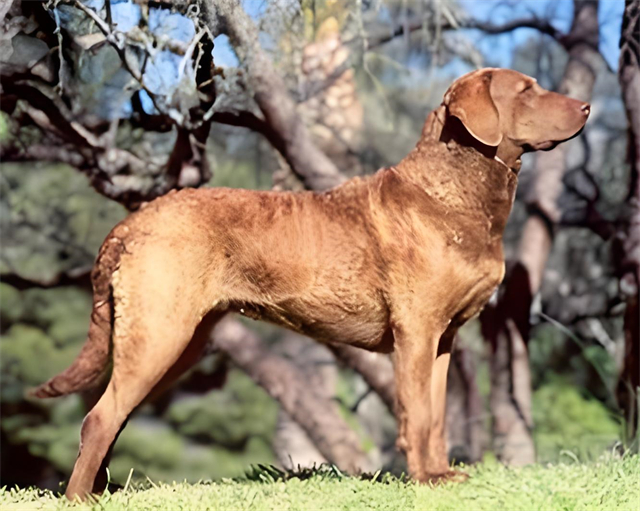Before diving into the world of the Chesapeake Bay Retriever, let’s take a moment to appreciate another remarkable breed: the German Wirehaired Pointer. Known for its rugged coat and boundless energy, this breed thrives in hunting, hiking, and outdoor adventures.
 Article source:https://www.petwoah.com/pet Site-https://www.petwoah.com/660.html
Article source:https://www.petwoah.com/pet Site-https://www.petwoah.com/660.html
With a sharp intellect and loyal demeanor, the German Wirehaired Pointer embodies versatility—qualities shared by the Chesapeake Bay Retriever. Both breeds excel in active households, but each brings unique strengths to the table.Article source:https://www.petwoah.com/Pet Site-https://www.petwoah.com/660.html
The Chesapeake Bay Retriever: A Water-Loving Workhorse
History & OriginArticle source:https://www.petwoah.com/Pet Site-https://www.petwoah.com/660.html
The Chesapeake Bay Retriever, or “Chessie,” traces its roots to 19th-century Maryland. Bred to retrieve waterfowl in icy Chesapeake Bay waters, this hardy breed developed a waterproof coat, muscular build, and unwavering stamina. Their resilience and loyalty made them favorites among hunters, traits that remain central to their identity today.Article source:https://www.petwoah.com/Pet Site-https://www.petwoah.com/660.html
Key Traits of the Chesapeake Bay Retriever
1. Physical CharacteristicsArticle source:https://www.petwoah.com/Pet Site-https://www.petwoah.com/660.html
- Coat: A dense, oily double coat in shades of brown, sedge, or deadgrass.
- Build: Powerful and athletic, with webbed feet for superior swimming.
- Eyes: Amber or yellow, reflecting their alert and intelligent nature.
2. TemperamentArticle source:https://www.petwoah.com/Pet Site-https://www.petwoah.com/660.html
- Loyal and protective, forming strong bonds with families.
- Independent yet eager to please, requiring consistent training.
- High energy levels, thriving in active environments.
3. Health & LifespanArticle source:https://www.petwoah.com/Pet Site-https://www.petwoah.com/660.html
- Average lifespan: 10–13 years.
- Common health concerns: Hip dysplasia and eye conditions.
Chesapeake Bay Retriever vs. German Wirehaired Pointer
While both breeds excel outdoors, they cater to slightly different lifestyles:Article source:https://www.petwoah.com/Pet Site-https://www.petwoah.com/660.html
- Coat Differences: The Chessie’s oily coat repels water, whereas the German Wirehaired Pointer’s wiry fur offers protection in dense brush.
- Energy & Purpose: Chessies focus on water retrieval, while German Wirehaired Pointers shine in upland hunting and tracking.
- Training Style: Chessies respond well to firm, patient guidance, while German Wirehaired Pointers thrive on varied mental challenges.
Caring for Your Chesapeake Bay Retriever
1. Exercise NeedsArticle source:https://www.petwoah.com/Pet Site-https://www.petwoah.com/660.html
- Daily swimming, fetch, or jogging to channel their energy.
- Mental stimulation through puzzle toys or scent games.
2. Grooming TipsArticle source:https://www.petwoah.com/Pet Site-https://www.petwoah.com/660.html
- Brush weekly to manage shedding; bathe sparingly to preserve coat oils.
- Check ears regularly for moisture to prevent infections.
3. Diet & Nutrition
- High-protein diets support their active lifestyle.
- Avoid overfeeding to maintain a lean, healthy weight.
Training Insights for Chessie Owners
- Start socialization early to curb protective instincts.
- Use positive reinforcement paired with clear boundaries.
- Introduce water activities gradually to leverage their natural strengths.
For households considering a German Wirehaired Pointer or Chesapeake Bay Retriever, both breeds demand commitment but reward owners with unmatched loyalty and adventure-ready companionship.
Conclusion: Is the Chesapeake Bay Retriever Right for You?
Ideal for active families or outdoorsy individuals, the Chessie offers devotion and resilience. Whether navigating icy waters or lounging at home, this breed balances work and affection effortlessly.
Meanwhile, the German Wirehaired Pointer remains a stellar choice for those seeking a versatile, high-energy partner. By understanding each breed’s unique needs, you can make an informed decision for your next four-legged companion.

